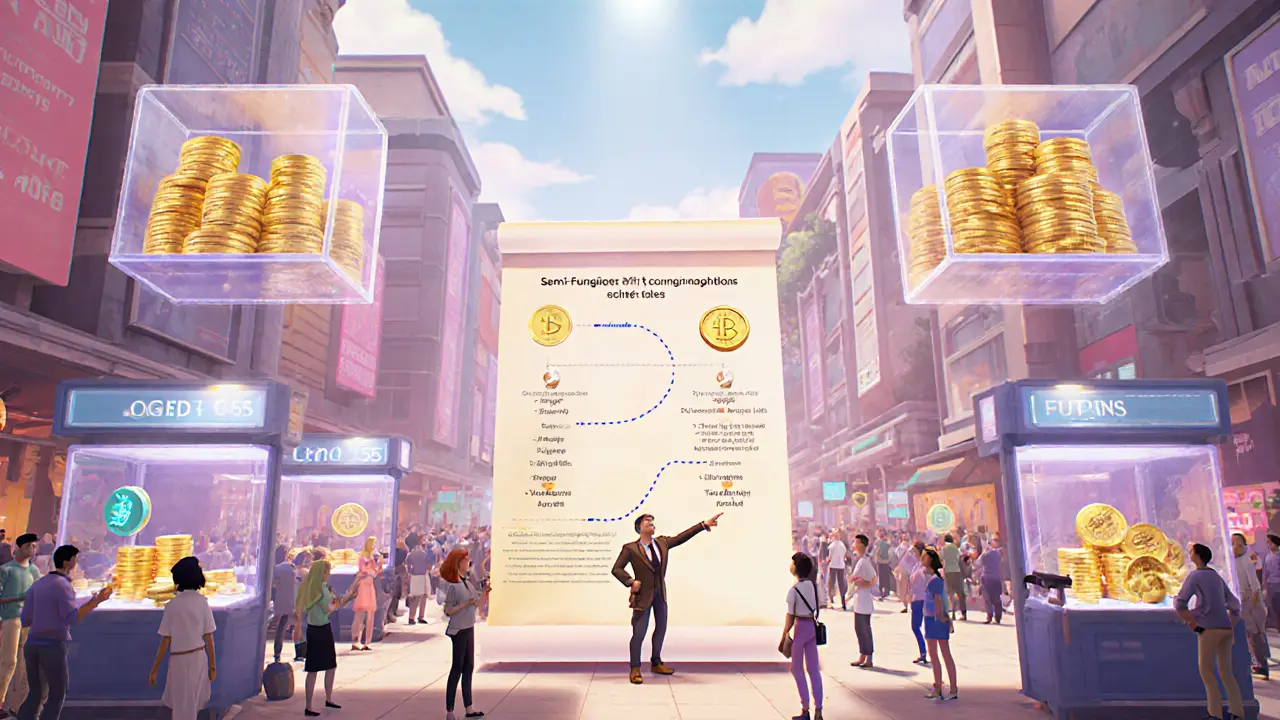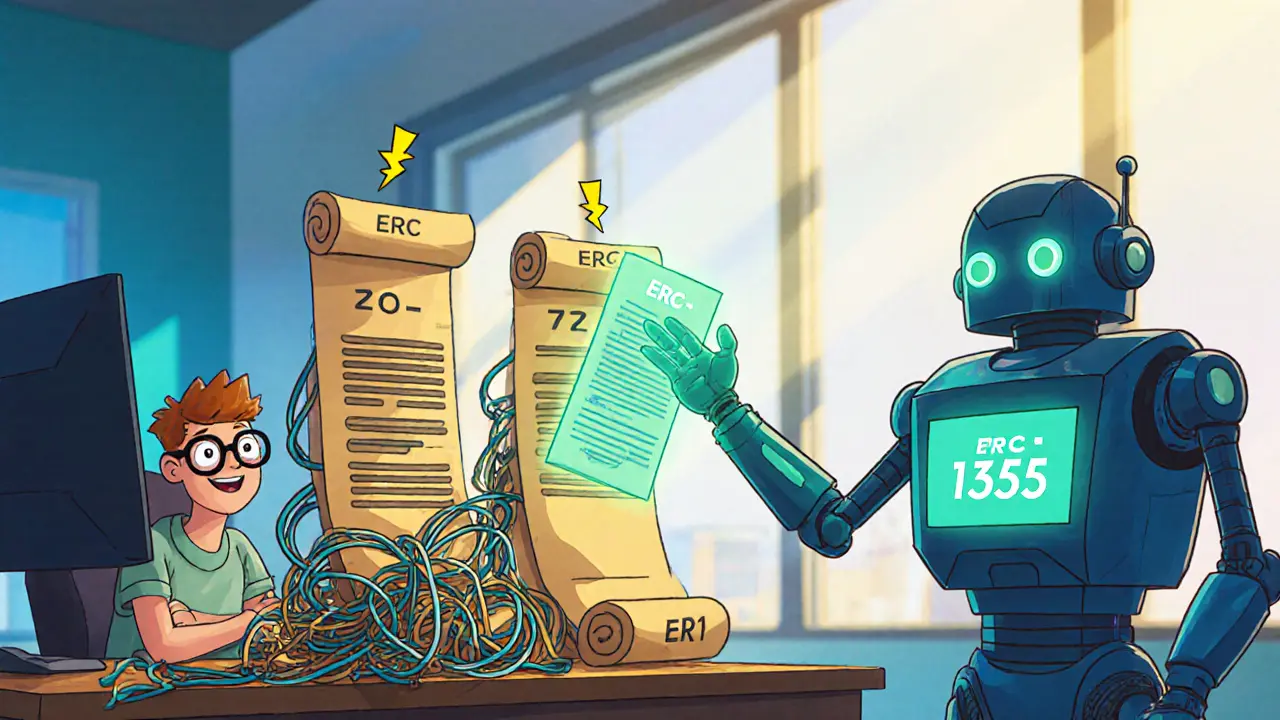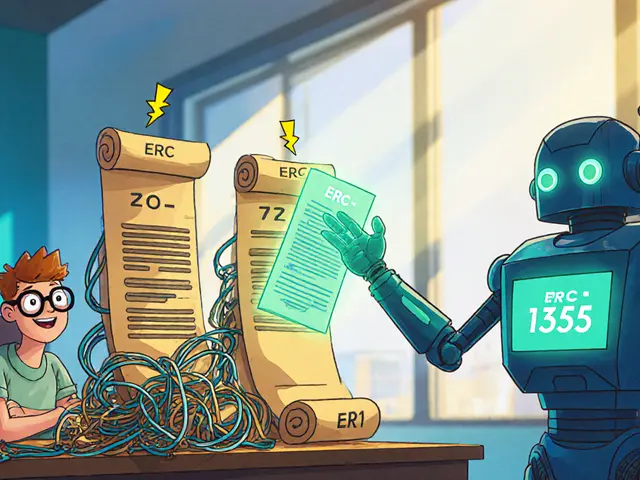When a project needs both coins and collectibles, developers used to spin up separate contracts for each token type, paying extra gas and managing a tangled codebase. ERC-1155 is a multi‑token standard on Ethereum that lets a single smart contract handle fungible tokens, non‑fungible tokens, and semi‑fungible tokens all at once. By collapsing three standards into one, it trims deployment costs, cuts transaction fees, and simplifies asset management-especially in gaming and metaverse projects.
Key Takeaways
- ERC‑1155 uses a single contract to manage any token type via unique uint256 IDs.
- Batch transfer functions reduce gas by up to 90% compared with multiple ERC‑20/721 calls.
- It shines for gaming, supply‑chain, and loyalty‑program use cases where mixed assets coexist.
- OpenZeppelin’s library powers ~89% of live ERC‑1155 contracts, but developers must master metadata URIs and safe transfer hooks.
- Security audits are crucial-early bugs around
safeTransferFromhave led to costly exploits.
What is ERC-1155?
ERC-1155 is a fungibility‑agnostic token standard (EIP‑1155) proposed by WitekRadomski of Enjin in 2018. It lets a contract store balances in a two‑dimensional mapping address => tokenId => balance, where each tokenId can represent a fully fungible coin, a unique NFT, or a semi‑fungible item that changes behavior over time.
This flexibility solves the “one contract per token type” problem that plagued ERC‑20 (fungible only) and ERC‑721 (NFT only). Instead of deploying three contracts for gold, swords, and a rare relic, a game can bundle them into one contract and interact with them via a single ABI.
Technical Architecture
At its core, ERC‑1155 defines the following key functions (all part of the IERC1155 interface):
balanceOf(address account, uint256 id)- returns the exact balance for a given token ID.balanceOfBatch(address[] accounts, uint256[] ids)- queries many balances in one call.safeTransferFrom(address from, address to, uint256 id, uint256 amount, bytes data)- moves a single token type.safeBatchTransferFrom(address from, address to, uint256[] ids, uint256[] amounts, bytes data)- moves multiple IDs at once.
Because each ID can be fungible or unique, the amount parameter is either a count of identical items or always 1 for a true NFT. The standard also requires the contract to implement the onERC1155Received and onERC1155BatchReceived hooks, ensuring that the destination address can handle the tokens safely.
Metadata is stored per‑ID via a URI template (e.g., https://api.example.com/metadata/{id}.json). This design enables distinct JSON files for each asset, a crucial feature for games that need separate artwork, stats, and rarity attributes.
Batch Transfers and Gas Savings
Gas is the biggest cost driver on Ethereum. A single ERC‑1155 batch transfer of ten different IDs typically consumes around 115000gas, while ten separate ERC‑20 or ERC‑721 transfers can exceed 450000gas. OpenZeppelin’s analysis (2023) shows a reduction of up to 90% when moving many items to the same address.
For a typical play‑to‑earn game where a player receives three weapons, two potions, and one rarity badge in one reward, the batch call saves not only ether but also reduces network congestion-making the user experience smoother.

How ERC-1155 Stacks Up
| Aspect | ERC‑20 | ERC‑721 | ERC‑1155 |
|---|---|---|---|
| Token Types | Fungible only | Non‑fungible only | Fungible, non‑fungible, semi‑fungible |
| Contract Count Needed | One per coin | One per collection | Single contract for mixed assets |
| Batch Operations | None (individual calls) | Limited (ERC‑721 Enumerable) | Built‑in batch transfer functions |
| Gas Cost (10 transfers) | ≈450k | ≈400k | ≈115k |
| Metadata Scope | Contract‑wide | Token‑level JSON | Token‑level URI template |
| Complexity | Low | Medium | Higher (ID management, hooks) |
In short, ERC‑1155 delivers the best of both worlds for projects that need variety, but it does ask developers to learn a richer API.
Real‑World Use Cases
Gaming is the primary arena where ERC‑1155 thrives. A single contract can represent:
- Bronze swords (fungible, ID1001, 10000 supply)
- Limited‑edition silver swords (semi‑fungible, ID2001, 500 supply)
- Legendary gold sword (non‑fungible, ID3001, supply1)
Enjin’s Minecraft plugin moved over 1.2million in‑game items with 92% lower gas than separate ERC‑20/721 contracts (Enjin case study, 2022).
Beyond games, supply‑chain platforms use ERC‑1155 to track pallets (fungible bulk units) alongside unique serial numbers for high‑value components. Loyalty programs leverage semi‑fungible tokens that start as points (fungible) and become redeemable vouchers (non‑fungible) once a threshold is hit.
Implementing ERC‑1155
For most developers, the easiest path is OpenZeppelin’s audited library. Install with npm install @openzeppelin/contracts and extend ERC1155:
pragma solidity ^0.8.0;
import "@openzeppelin/contracts/token/ERC1155/ERC1155.sol";
contract MyGameAssets is ERC1155 {
constructor(string memory uri) ERC1155(uri) {}
function mint(address to, uint256 id, uint256 amount, bytes memory data) public {
_mint(to, id, amount, data);
}
}
Key steps to avoid common pitfalls:
- Define a clear ID allocation strategy. Reserve ranges for fungible (e.g., 0‑9999), semi‑fungible (10000‑19999), and NFTs (20000+). This prevents accidental ID collisions.
- Implement
uri(uint256 id)to return per‑ID metadata. Store JSON files on IPFS or a reliable CDN; include attributes likename,image,rarity. - Override
_beforeTokenTransferif you need custom business logic (e.g., preventing transfers of locked items). - Test the
onERC1155Receivedhook thoroughly. Many early exploits stemmed from contracts not checking the return value, allowing tokens to be locked in non‑compliant wallets. - Run a security audit. OpenZeppelin’s 2022 audit found 68% of contracts had at least one moderate issue, mostly around access control.
Expect a learning curve of roughly 15‑25hours if you already know ERC‑20/721, according to a 2023 Stack Overflow survey.

Security & Auditing
ERC‑1155’s flexibility introduces new attack surfaces. The most cited flaw is improper handling of the safe transfer callbacks, which can result in tokens being sent to contracts that cannot retrieve them. To mitigate:
- Require
ERC1155Receivercompliance checks. - Restrict who can call mint/burn functions, using
onlyOwneror role‑based access. - Validate input lengths for batch arrays to prevent out‑of‑bounds errors.
Recent audits (OpenZeppelin 2022, Certik 2021) recommend enabling re‑entrancy guards on external calls and using the latest Solidity compiler version (≥0.8.19) for built‑in overflow checks.
Adoption & Market Trends
ERC‑1155 now accounts for roughly 38% of NFT‑related activity on Ethereum as of Q22023, up from 19% in 2021 (DappRadar). Gaming projects using the standard grew from 41% to 73% in the same period, reflecting its gas‑saving advantage.
Enterprise pilots are emerging too-43 Fortune500 firms have tested ERC‑1155 for supply‑chain tokenization and customer loyalty tokens (Gartner2023). The standard’s cross‑chain support on Polygon, BNB Chain, and Avalanche further widens its reach.
Future Outlook
Upcoming improvements focus on tighter integration with account abstraction (ERC‑4337). The Ethereum Foundation’s Q32023 roadmap predicts an additional 30‑40% gas reduction for ERC‑1155 transfers when combined with abstracted accounts. OpenZeppelin’s 4.8.0 release (May2023) already added optimized storage patterns that shave another ~5% off gas.
Analysts at Gartner forecast that by 2025, ERC‑1155 will power over half of all blockchain gaming asset transfers, while continued security hardening should push exploit rates below 5% of total token‑related incidents.
Frequently Asked Questions
What advantages does ERC-1155 have over ERC-20 and ERC-721?
ERC-1155 can manage fungible, non-fungible, and semi-fungible tokens in a single contract, cutting deployment costs and allowing batch transfers that save up to 90% gas compared with separate ERC-20 or ERC-721 calls.
Do I need to write my own metadata system?
ERC-1155 expects a URI template per token ID. Most developers host JSON files on IPFS or a CDN; the contract only returns the URI, while the off‑chain file contains name, image, and attributes.
Is ERC-1155 compatible with major NFT marketplaces?
Major platforms like OpenSea support ERC-1155 collections, but custom metadata handling may be required for some marketplaces. Testing display on each target platform is advisable.
How do I secure my ERC-1155 contract?
Use OpenZeppelin’s audited implementation, restrict mint/burn functions with role‑based access, enable re‑entrancy guards, and verify the receiver hook returns the correct selector.
Can ERC-1155 be used on non‑Ethereum chains?
Yes. The standard is implemented on Polygon, BNB Chain, Avalanche, and even on NEAR via compatible wrappers, allowing the same contract logic across EVM‑compatible ecosystems.



Comments
ERC‑1155 is just a marketing gimmick that overcomplicates simple token use.
Hey folks, if you’re just starting with multi‑token contracts, try sketching out your ID schema on paper first.
It helps avoid the dreaded collisions later on.
Also, don’t forget to host your metadata on IPFS for true decentralization.
Testing the onERC1155Received hook with a mock wallet can save hours of debugging.
Lastly, keep your batch sizes reasonable – huge batches can hit block gas limits.
The real benefit of ERC‑1155 for American developers is the cost savings on gas.
Deploying a single contract instead of three cuts both time and money.
Our startup used it to bundle loyalty points and exclusive NFTs with great results.
It’s a home‑grown solution that keeps everything on‑chain and under US jurisdiction.
Imagine a game where swords, potions, and rare artifacts all come from one contract – that’s the drama ERC‑1155 brings.
It’s like watching a symphony where each instrument plays its part without needing a separate orchestra.
Developers, embrace the flexibility and let your imagination run wild.
To the community, I would recommend a methodical approach when integrating ERC‑1155.
First, define clear token‑ID ranges for each asset class.
Second, ensure that the URI template resolves correctly for every token.
Third, conduct thorough unit tests on batch transfers to verify gas estimates.
Batch ops are cool but don’t forget the edge cases.
Missing return values can lock tokens forever.
I’ve seen teams struggle with metadata inconsistency; using a CI pipeline to validate JSON schemas before deployment helps a lot.
It keeps the marketplace experience smooth for users.
Ethical developers must ensure that token minting rights aren’t open to anyone.
Restrict access and you safeguard the ecosystem.
One might ponder whether the fragmentation of tokens into fungible, semi‑fungible, and non‑fungible categories reflects a deeper ontological split in digital assets.
Perhaps the standard is a mirror of our desire to categorize value itself.
Nevertheless, practical implementation beats philosophical musings.
When you set up your ERC‑1155 contract, remember to use OpenZeppelin’s latest version – it includes the re‑entrancy guard you need.
Also, double‑check the spelling of your URI; a typo can break all token displays.
Contrary to popular hype, ERC‑1155 isn’t a silver bullet for every project.
For simple token economies, the added complexity may be unnecessary.
Evaluate your use‑case before jumping in.
They don’t tell you that the real power behind ERC‑1155 lies in the hidden backdoors that big corporations reserve for themselves.
Stay vigilant.
Let’s coordinate on a shared ID schema so our projects don’t clash later.
I’m happy to merge pull requests.
From a standpoint of national pride, adopting ERC‑1155 showcases American ingenuity in blockchain engineering.
It reduces operational costs, thereby strengthening our technological competitiveness on the global stage.
The standard’s batch capabilities are a testament to efficient design.
Alright, let’s break this down step by step so even newcomers can follow.
First, understand that ERC‑1155 uses a two‑dimensional mapping: address => tokenId => balance, which is the backbone of its flexibility.
Second, decide on an ID allocation strategy; a common pattern is to reserve 0‑9999 for pure fungible tokens, 10000‑19999 for semi‑fungible items, and 20000+ for true NFTs.
Third, when you write the contract, inherit from OpenZeppelin’s ERC1155 implementation – it already includes the safe transfer hooks and re‑entrancy protection you’ll need.
Fourth, implement the uri(uint256) function to return a token‑specific URL; most teams host a JSON file per token on IPFS that contains name, image, and attributes.
Fifth, test the onERC1155Received and onERC1155BatchReceived callbacks thoroughly – forgetting to check the return selector can lock tokens in non‑compliant wallets.
Sixth, when you design batch transfers, remember that the gas savings come from amortizing the base transaction cost across multiple IDs; however, keep batch sizes reasonable to avoid hitting block gas limits.
Seventh, if you plan to expose your tokens on marketplaces like OpenSea, verify that the metadata schema matches their expectations, or you’ll see broken images.
Eighth, add role‑based access control for minting and burning functions; the onlyShould be a minter role or the contract owner, not an open function.
Ninth, enable the ERC2981 royalty standard if you want creators to earn secondary‑sale royalties – it works seamlessly with ERC‑1155.
Tenth, run static analysis tools like Slither or MythX before you push to mainnet, catching common pitfalls such as uninitialized storage pointers.
Eleventh, consider deploying on a layer‑2 like Polygon if you need even lower fees; the ERC‑1155 bytecode is identical, and the gas savings multiply.
Twelfth, monitor your contract after deployment with a block explorer and a custom dashboard that tracks batch transfer volumes – this helps you spot abnormal activity early.
Thirteenth, write comprehensive documentation for your token IDs; future developers will thank you when they need to add new asset types.
Fourteenth, keep your compiler version up to date (≥0.8.19) to benefit from built‑in overflow checks and other safety features.
Fifteenth, finally, plan for upgradability if you anticipate major changes – use a proxy pattern that preserves storage layout.
By following this checklist, you’ll avoid most of the common bugs that have plagued early ERC‑1155 projects and set yourself up for a smooth, gas‑efficient launch.
Yo, the ERC‑1155 vibe is lit for game devs who want to drop swag without breaking the bank.
Batch ops are the real MVP – think of them as bulk‑send APIs for in‑game loot.
Just make sure your token‑URI points to a CDN that can handle the traffic surge when a new season drops.
Also, lock down your minter role with AccessControl; you don’t want rogue airdrops raining on the economy.
Bottom line: you get flexibility, gas savings, and the ability to spin up new asset classes on the fly – perfect for the fast‑paced NFT‑gaming arena.
While the community waxes poetic about ERC‑1155’s elegance, let’s not ignore the fact that the standard adds an extra layer of complexity that many teams simply aren’t ready to handle.
Mis‑configured batch arrays can cause out‑of‑bounds errors that lock user assets forever.
And the reliance on onERC1155Received hooks creates a surface for denial‑of‑service attacks if not properly guarded.
Bottom line: proceed with caution, or you’ll end up paying the price.
One must contemplate the epistemic ramifications of conflating fungible and non‑fungible constructs within a singular standard.
The ontological purity of ERC‑20 and ERC‑721 is, in my estimation, compromised by the pragmatic amalgamation presented by ERC‑1155.
Nevertheless, the commercial incentives-namely gas economization and deployment efficiency-cannot be dismissed outright.
From a scholarly perspective, this synthesis may herald a new paradigm in token taxonomy, albeit one fraught with implementation intricacies.
It behooves the discerning developer to weigh theoretical rigor against operational exigency.
Assertively speaking, the ERC‑1155 specification suffers from a lack of formal verification in many third‑party implementations.
Developers often trust OpenZeppelin without auditing the underlying bytecode, which is a dangerous complacency.
Furthermore, the standard’s reliance on external metadata introduces a vector for supply‑chain attacks.
In short, treat ERC‑1155 as a tool, not a silver bullet, and subject it to rigorous testing.
Nice checklist, but if I wanted to read the whole thing I’d just watch a 5‑minute YouTube explainer.